40 Life Changing Devices & Services for the Visually Impaired
These are 40 of my favorite devices for the visually impaired. These items can enrich your patients, your loved ones, or your own lives. If you or your loved one is visually impaired, it's important to have a low vision examination with us to discuss which items are best for you.
For bigger text, Hold CTRL and press (+) key.
1. HIGH STRENGTH READING GLASSES For reading. The simplest, must-have solution to visual impairment. Reading glasses that are high strength are an essential purchase. Because these reading glasses will be very strong, it is best to purchase them in single vision or executive bifocal. No-line bifocal (progressive) lenses are not an option: they do not come in high enough strength. You will need to hold your reading material closer than normal due to the high strength of these glasses. Experiment with different reading distances.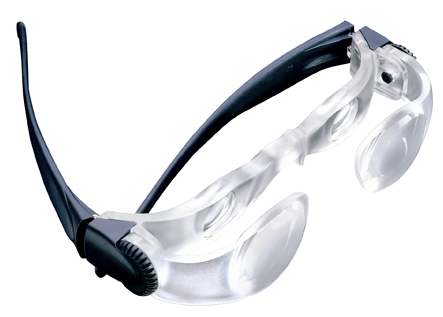
2. BINOCULAR / TELEMICROSCOPE GLASSES For long term, seated distance. The MAX TV binocular glasses: A must-have device for anyone who enjoys sporting events, family graduations, or watching television. You can't walk in these binocular glasses, but they will enhance your distance vision by 1.75-2.00x. They are relatively lightweight, but are heavier than normal glasses. Someone who has a lot of astigmatism in their glasses may prefer the clip-on Max TV instead of the traditional device. Price is about $130, or $40 for a low-quality generic alternative.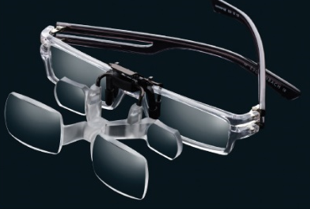
3. CLIP ON BINOCULAR GLASSES (MAXDETAIL CLIP) These are much like the regular MAX TV binocular glasses, except they clip onto your existing distance glasses. This makes them much more suitable for someone with a strong prescription. These can sometimes be too heavy and may not fit your glasses well. Price is around $100-$200.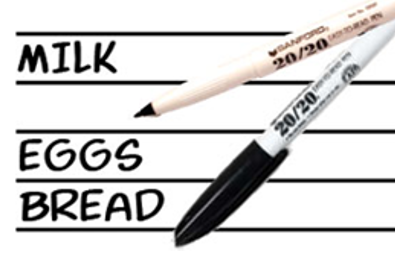
4. "20/20" EXTRA THICK BALLPOINT PENS For reading and writing. These ballpoint pens are not as bulky as markers but not as thin as a regular pen. They allow you to write notes to yourself without struggling to read them later on. Once you start using the 20/20 pen, it is hard to go back. Buy some extras for your family because everyone will love this pen! Price is around $1-$5.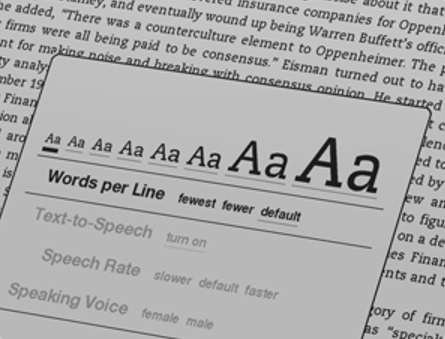
5. EBOOK READERS (NOOK, KINDLE) For reading. E-Book readers are an incredibly popular and fairly priced way to read. Almost all books are available in any font size at the touch of a button. Even older patients can use e-books with the help of a family member. The text size is adjustable so you can make the text very large and easy to read. The selection of books on e-book readers is much larger than the selection of large-print books. Many e-book readers have text-to-speech, so when you get tired you can have your reader read to you! I feel that an e-book reader is a must-have for every visually impaired patient. I recommend a Barnes and Noble Nook or Amazon Kindle. Prices range from $100-$500.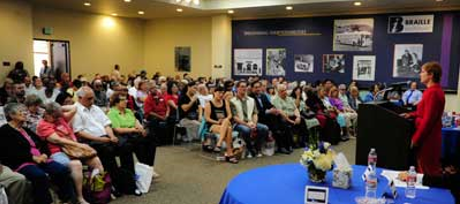
6. BRAILLE INSTITUTE CLASSES & SUPPORT GROUPS The Braille Institute is not only for the blind. They have many resources for the moderately to severely visually impaired. These resources are numerous, but I most highly recommend support groups for those who are new to visual impairment. Not only is your life not over, but you can lead a rich and fulfilling life. Sometimes a person can take their impairment as an opportunity for positive change—leaving him or her more fulfilled after their impairment than they were before. Braille support classes can help you achieve this too.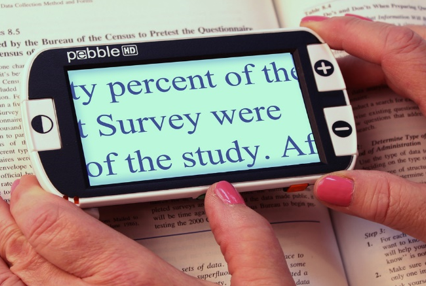
7. ELECTRONIC STAND & HAND MAGNIFIER (DISCREET) For short and long-term reading. The Pebble is a versatile and discreet electronic portable magnifier. It can be placed directly against a page to act as a stand magnifier, or you can twist out the handle and use it as a hand magnifier. Yet its appearance is discreet enough it will go unnoticed by people around you. This is an electronic device and is made to be easy to operate, but some older patients may have difficulties. Price ranges from $400-$700.
8. ELECTRONIC STAND/HAND MAGNIFIER (COLORED BUTTONS)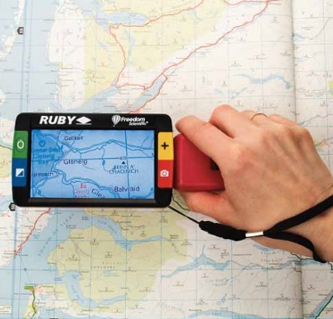 For short and long-term reading. The Ruby Pebble is a versatile electronic portable magnifier with easy-to-see buttons. Like many other electronic hand magnifiers, it can be placed directly against a page to act as a stand magnifier, or you can twist out the handle and use it as a hand magnifier. This is an electronic device and is made to be easy to operate, but some older patients may have difficulties. Price ranges from $500-$1,000.
For short and long-term reading. The Ruby Pebble is a versatile electronic portable magnifier with easy-to-see buttons. Like many other electronic hand magnifiers, it can be placed directly against a page to act as a stand magnifier, or you can twist out the handle and use it as a hand magnifier. This is an electronic device and is made to be easy to operate, but some older patients may have difficulties. Price ranges from $500-$1,000.
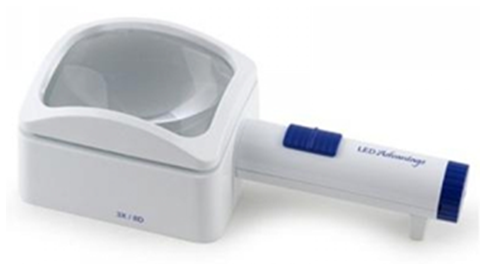
9. STAND MAGNIFIERS For reading. There are many stand magnifiers made by many companies (my favorites are Fletcher and Eschenbach brands). A stand magnifier is any magnifier that is set directly on the page of a book or other reading material. This allows you to read without lifting a magnifier for long periods, so your arm won't get tired. It should be noted that it takes some dexterity to operate a stand magnifier as you must control it and move it along the page as you read. Stand magnifiers are not as portable as hand magnifiers. Come in 2X-10X range. Cost varies greatly by quality and self-lighting, from $20 to $300.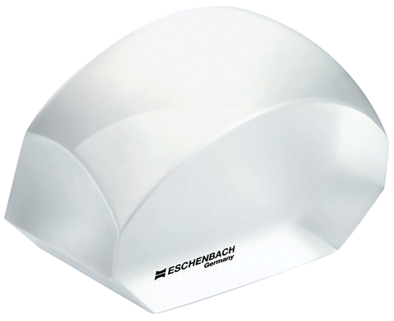
10. ESCHENBACH WEIGHTED DOME MAGNIFIER For reading. A variant of the stand magnifier. The appearance of this stand magnifier is both beautiful and practical. Its weight helps the user keep their place on the page and gives it excellent optical quality. Its shape is very intentional, created to direct as much light to the page as possible. Round shapes are available. There are several dome magnifiers by many companies, but I recommend the Eschenbach line. Comes in 1.5X-3X. Prices range from $300-$600.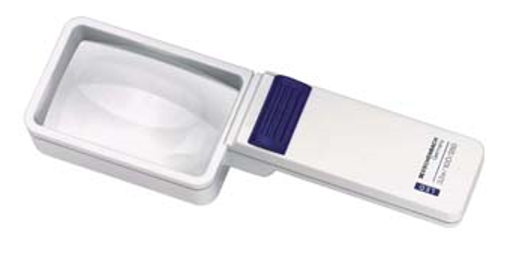
11. HAND MAGNIFIER For short-term reading. Unlike the stand magnifier, a hand magnifier must be held up at all times between the patient and the object being viewed. It is not pressed against the patient's eyes like glasses, nor is it pressed against the paper like a stand magnifier. This makes hand magnifiers excellent for short periods at a time, quickly looking at ingredients lists at a grocery store or directions on a pill bottle. Hand magnifiers are not for reading books. Comes in 2X-10X range. Cost varies greatly by quality and self-lighting, from $20 to $300. Spending the extra money on a higher quality magnifier is worth it, if financially viable.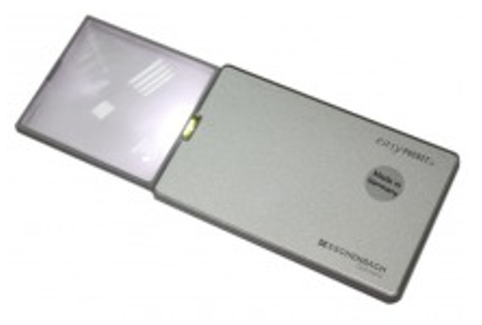
12. FRESNEL PORTABLE/SLIDE OUT MAGNIFIER For short-term reading. These portable hand magnifiers sacrifice quality of vision for portability. For young, on-the-go people, this is a must-have item. Great for grocery shopping and reading menus at restaurants. By utilizing Fresnel technology, this hand magnifier is extremely lightweight, flat, and portable. This item is discreet and fits perfectly in a purse, making it ideal for independent women. My favorite type of portable hand magnifier is the Easy Pocket LED Portable Magnifier. Remember that the optical (image) quality will not be as good as a traditional hand magnifier. Costs vary.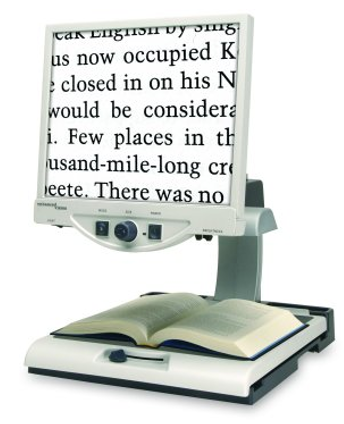
13. CC-TV ELECTRONIC HOME MAGNIFIER For long-term at-home reading. There are a number of these devices, and most of them are incredibly easy to use, making them appropriate for any age. Simply place an item on the table and view a 2-30x magnified image of it on the screen above. These machines are very large and can be expensive, with price ranges from $2,000-$3,000. Add-Ons: Some CCTV's have unique abilities such as portability, white text on a black background, text color changes, and 'OCR' technology that reads text out loud for you.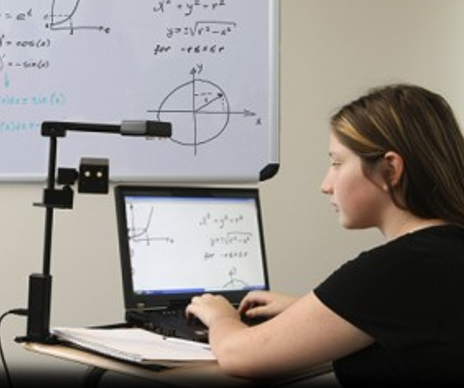
14. ZOOM TWIX NEAR & FAR LAPTOP MAGNIFIER For students, distance and near. This is the perfect device for high-intensity students who want to get through school without drawing unnecessary attention or asking for special help. By utilizing your laptop screen as a monitor, the Zoom Twix compacts a traditional CCTV into a very small portable device that can be quickly set up in the classroom. Battery-powered. The real magic of the Zoom Twix is that the camera can be aimed at both distance or near. Simply twist the head of the device, and you can quickly see what your professor is writing on the board, then twist it back to your book to follow along with your class. Price is comparable to other CCTVs.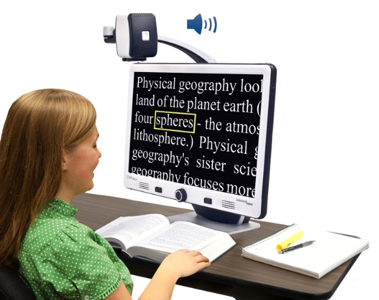
15. TEXT TO SPEECH OCR TECHNOLOGY For reading. This variant of the traditional OCR takes the text from your book and reads it for you. This is very useful for someone who is severely impaired. You can follow along with the voice by watching the screen in front of you. Not recommended for people that have a difficult time with technology. Prices vary and can be expensive.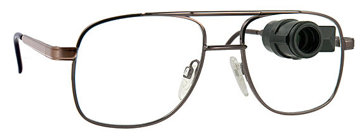
16. MONOCULAR TELESCOPIC DRIVING GLASSES For driving. These glasses have a built-in telescope at the top of the frames, allowing the user to tilt their head downward and use the telescope whenever they need, hands-free. These are excellent for seeing signs when driving. It is important to note that looking through the telescope piece is only for seeing street signs and will not help you pass a driving test and should not be used for more than a few seconds at a time. Costs vary greatly.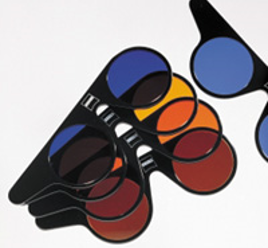
17. COLOR FILTERS / LENS TINTS All distances. Our glasses laboratory can tint your lenses various colors. Depending on your medical condition, certain tints may improve your subjective vision by a noticeable increment. Many patients especially enjoy yellow tint, amber tints, and pink tints. Patients who are sensitive to the light can get dark grey or brown tints, and if they are especially sensitive, we can tint the glasses with extra-dark tints, making them darker than sunglasses. Tints are not for everyone. Prices range from a $30-$100 addition to your glasses cost.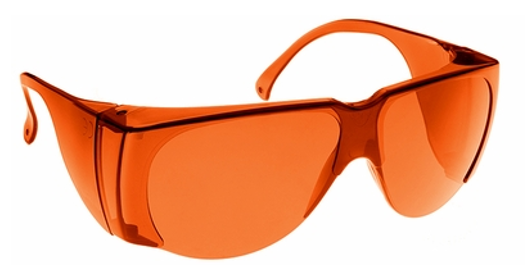
18. SIDE BLOCKING FILTERS For outdoors. These 'filters' are basically sunglasses that are large enough to fit around your regular glasses. They block all incoming light, even light from the sides and above your normal glasses frame. They can come in many tints. The most popular brands for these frames are NoIR and Cacoon. The price varies greatly by quality, from $50 to $300.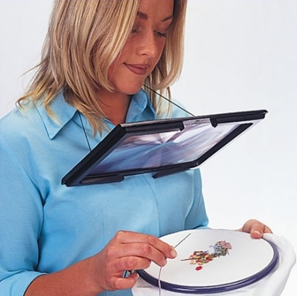
19. HOBBY MAGNIFIER For intermediate distances. These are sometimes called 'knitting magnifiers' but are useful for much more than just knitting. This magnifier is large and wraps around your neck so that you can better see your hobbyist activity. It is hands-free. Because they only provide a 1.75X magnification, they are only for patients with a mild or moderate impairment. Prices can range greatly by quality, from $50 to $300.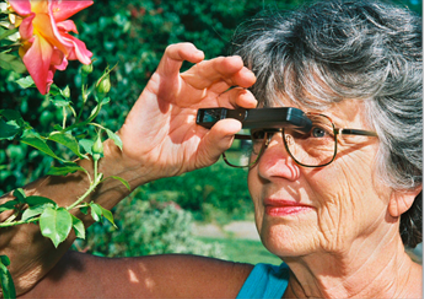
20. MOUNTED FLIPPING TELESCOPE For distance/walking. There are many mounted flipping telescopes, but my favorite is the Ocutech Sight Scope. This device is mounted on your glasses at the top of the frame. They have a hinge, allowing you to flip them away from your central vision when not in use. That way, you can walk around while they are on. When you are ready to sit and use the telescope portion to view events at a distance, simply flip the telescope down. Comes in several distance magnifications, from 1.5X to 4X. Costs vary but tend to be very expensive.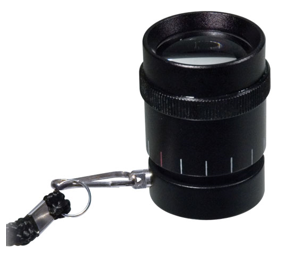
21. PORTABLE TELESCOPE OR MINIFIER For distance. A portable telescope fits easily in your pocket or purse and can be used for viewing things at a distance. These are not made for reading or driving, but perhaps looking at street signs while walking or enjoying a view while on vacation. Comes in many distances and sizes, from 1.5X to 8X. Prices vary. Alternative Use: This device can also be used as a minifier if reversed. This can be helpful for people with 'tunnel vision'. Your doctor will tell you if this use is appropriate for you.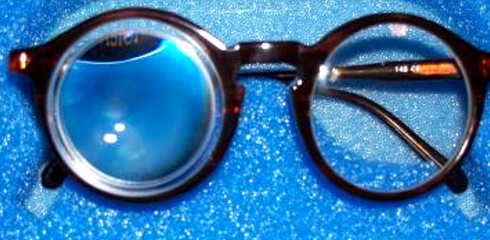
22. MONOCULAR MICROSCOPIC SPECTACLES For reading. These glasses are so extremely powerful that they are best used through one eye at a time—which is why the reading power is only in one eye. These are great for people with severe visual impairments but can be cumbersome: Although they are hands-free, the user must hold their reading material extremely close in order to see it with these incredibly high-power lenses. Magnification ranges from 4X to 7X. Prices vary.
23. DISTANCE GLASSES OR PRISM GLASSES Distance glasses are an important part of mobility and good vision. If you are experiencing double vision or eyestrain, prism can be added to your distance and near glasses to help.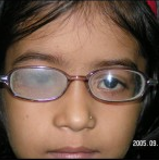
24. MONOCULAR / FROSTED LENS The purpose of a frosted lens is to eliminate double vision by blurring the vision out of one eye. It is done when other solutions to your double vision, such as prism, fail.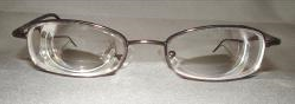
25. HIGH POWER MOUNTED LENS Some patients require a glasses prescription so strong that a traditional optometrist or optician does not know where to order them or how to help a patient with frame selection. The key to these high powers is either using a lens mounted within another lens to decrease the thickness or to polish the exposed edges of the lens to avoid a cosmetically-unpleasant frosted appearance. Prices vary greatly.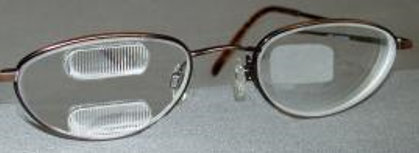
26. PERIPHERAL VIEWING "PELI" LENS For orientation. These lenses are very special and only for patients who are missing large portions of their peripheral (side) vision.
27. LARGE PRINT BOOKS & CROSSWORD For reading. Large print books are perfect for someone unwilling to use or unable to afford an e-book reader. Ask your local librarian if your condition qualifies you for free access to books. Most libraries have a wide variety of large print books for the visually impaired.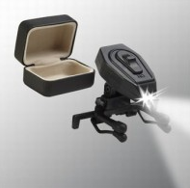
28. SPECLIGHTS CLIP ON PERSONAL LIGHT Lighting. This personal light clips onto the front of your glasses like a headlamp, giving you light everywhere you go. They are relatively lightweight for being mounted on glasses, but the amount of light still may not be enough for optimal reading.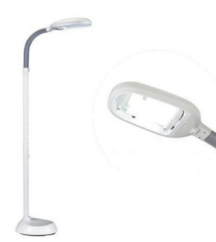
29. HIGH LUMEN (BRIGHT) FLOOR LAMPS Lighting. Floor lamps are almost always the best way to light your home. Adequate lighting is one of the most important factors in everyday living for the visually impaired. Do not underestimate high-quality lighting. Look for bright, natural, floor lamps that have an adjustable head. Avoid lamps that light in all directions; instead, aim the lamp's light directly over your shoulder at your reading material. Good lighting can have a massive effect for a visually impaired individual. If you are not sure if your home has good lighting, please ask your optometrist or occupational therapist to do an in-home assessment.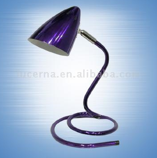
30. HIGH LUMEN (BRIGHT) SNAKE LAMP These snake-style lamps can be great for putting in hard-to-reach areas. Remember to try and create strong directional light sources that sit behind your shoulder and aim at your reading material.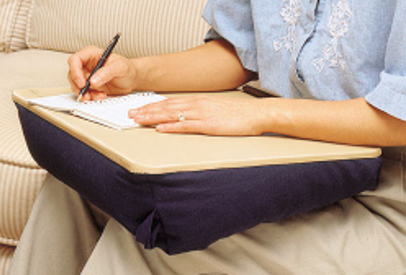
31. BEAN BAG LAP TABLE Ergonomics. This device is not for everyone because it creates a reading and writing surface on your lap. It can be helpful, but keep in mind that you may need to hold your reading material closer than your lap if you have high-strength reading glasses. Do not eat or place drinks on a bean bag lap table.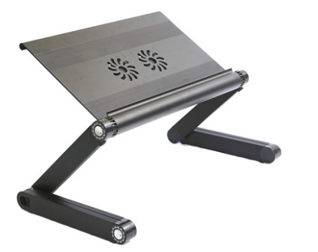
32. ADJUSTABLE LAPTOP AND READING TABLE There are several types of these reading tables, and they are becoming very popular as more and more people utilize laptops. If adjusted appropriately, tables like these can place your reading material at almost any distance from your eyes, which is ideal for those who need to hold books extra close for reading.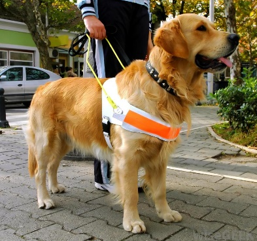
33. SEEING EYE DOG Mobility/Independence. You may be surprised to learn you are eligible for a seeing-eye dog. You must be a mobile but legally blind person. There is a limited amount of animals available, so you must apply and are not guaranteed selection. Price: sometimes free, but could be up to $50,000 if privately adopted.
34. THERAPY DOGS Adopting a pet can save your life, and it is guaranteed to save theirs. If you are not sure if you can adequately care for an animal, discuss it with your optometrist and your occupational therapist. The bond between you and your companion animal can be every bit as strong as one between two people. Enrich your life by saving an animal. There are programs to help pay for caring for your therapy animal.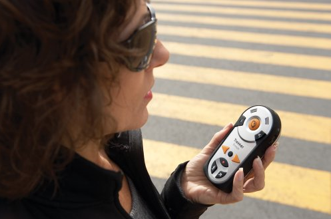
35. HUMANWARE TALKING GPS FOR THE BLIND Mobility/Independence. Humanware devices are traditionally for people who are completely blind. However, this device is just so helpful that it is worth having a look at for the severely impaired. Humanware devices have allowed the blind to be more mobile and independent than ever in the past.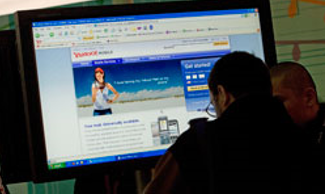
36. OVER-SIZED COMPUTER MONITOR Your optometrist or occupational therapist can help you set up an old or new large-screen TV as a computer monitor. This is not the most elegant or ideal option, but it is a very affordable option to experiment with.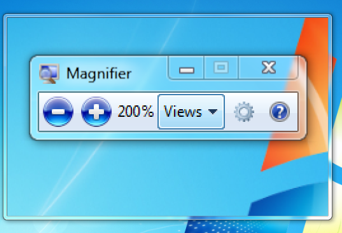
37. COMPUTER ACCESSIBILITY TRAINING Your optometrist and/or occupational therapist can train you on how to utilize built-in tools on your computer to magnify and better see your screen. In your internet browser, try holding CTRL and pressing the + key to make the text larger across most websites.
38. COMPUTER PROGRAMS There are several programs you can install on your computer to help you magnify and see your screen and work. Some popular ones are ZoomText, CDesk, and Magic Zoom. Your optometrist or occupational therapist can help you install and use these tools to maximize efficiency if you work often on the computer.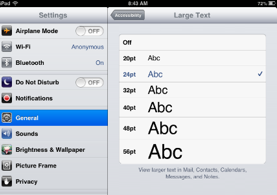
39. PHONE AND TABLET ACCESSIBILITY TRAINING Most phones and tablets can have the font increased in size across the entire device, from app names to text messages. Ask your optometrist, occupational therapist, or the customer support of the company that makes your device to get help.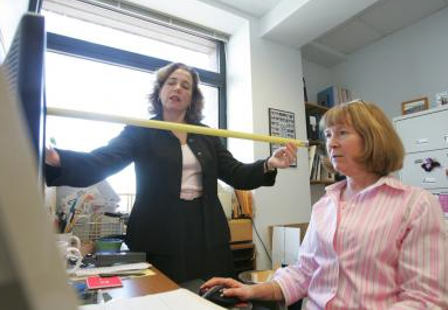
40. IN-HOME OCCUPATIONAL THERAPY An Occupational therapist works with you in your home to train you with devices, help you with everyday living strategies such as organizing food and medications, furniture placement, ideal lighting placement, computer ergonomics, and pet care. There are different types of occupational therapists, so make sure to choose one who is familiar with low vision (visual impairments).
Discuss which of the 40 are best for you and your specific situation with your low vision optometrist. We are always happy to assist you in the purchase process and discussion on these products, but we do not directly sell some of the products above. Because of expense and size, our office has many, but not all of these products on hand for you to try.Call us at [office] at [phone] for your annual exam, your low vision exam, or with your questions about your condition and vision.

1. HIGH STRENGTH READING GLASSES For reading. The simplest, must-have solution to visual impairment. Reading glasses that are high strength are an essential purchase. Because these reading glasses will be very strong, it is best to purchase them in single vision or executive bifocal. No-line bifocal (progressive) lenses are not an option: they do not come in high enough strength. You will need to hold your reading material closer than normal due to the high strength of these glasses. Experiment with different reading distances.

2. BINOCULAR / TELEMICROSCOPE GLASSES For long term, seated distance. The MAX TV binocular glasses: A must-have device for anyone who enjoys sporting events, family graduations, or watching television. You can't walk in these binocular glasses, but they will enhance your distance vision by 1.75-2.00x. They are relatively lightweight, but are heavier than normal glasses. Someone who has a lot of astigmatism in their glasses may prefer the clip-on Max TV instead of the traditional device. Price is about $130, or $40 for a low-quality generic alternative.

3. CLIP ON BINOCULAR GLASSES (MAXDETAIL CLIP) These are much like the regular MAX TV binocular glasses, except they clip onto your existing distance glasses. This makes them much more suitable for someone with a strong prescription. These can sometimes be too heavy and may not fit your glasses well. Price is around $100-$200.

4. "20/20" EXTRA THICK BALLPOINT PENS For reading and writing. These ballpoint pens are not as bulky as markers but not as thin as a regular pen. They allow you to write notes to yourself without struggling to read them later on. Once you start using the 20/20 pen, it is hard to go back. Buy some extras for your family because everyone will love this pen! Price is around $1-$5.

5. EBOOK READERS (NOOK, KINDLE) For reading. E-Book readers are an incredibly popular and fairly priced way to read. Almost all books are available in any font size at the touch of a button. Even older patients can use e-books with the help of a family member. The text size is adjustable so you can make the text very large and easy to read. The selection of books on e-book readers is much larger than the selection of large-print books. Many e-book readers have text-to-speech, so when you get tired you can have your reader read to you! I feel that an e-book reader is a must-have for every visually impaired patient. I recommend a Barnes and Noble Nook or Amazon Kindle. Prices range from $100-$500.

6. BRAILLE INSTITUTE CLASSES & SUPPORT GROUPS The Braille Institute is not only for the blind. They have many resources for the moderately to severely visually impaired. These resources are numerous, but I most highly recommend support groups for those who are new to visual impairment. Not only is your life not over, but you can lead a rich and fulfilling life. Sometimes a person can take their impairment as an opportunity for positive change—leaving him or her more fulfilled after their impairment than they were before. Braille support classes can help you achieve this too.

7. ELECTRONIC STAND & HAND MAGNIFIER (DISCREET) For short and long-term reading. The Pebble is a versatile and discreet electronic portable magnifier. It can be placed directly against a page to act as a stand magnifier, or you can twist out the handle and use it as a hand magnifier. Yet its appearance is discreet enough it will go unnoticed by people around you. This is an electronic device and is made to be easy to operate, but some older patients may have difficulties. Price ranges from $400-$700.
8. ELECTRONIC STAND/HAND MAGNIFIER (COLORED BUTTONS)
 For short and long-term reading. The Ruby Pebble is a versatile electronic portable magnifier with easy-to-see buttons. Like many other electronic hand magnifiers, it can be placed directly against a page to act as a stand magnifier, or you can twist out the handle and use it as a hand magnifier. This is an electronic device and is made to be easy to operate, but some older patients may have difficulties. Price ranges from $500-$1,000.
For short and long-term reading. The Ruby Pebble is a versatile electronic portable magnifier with easy-to-see buttons. Like many other electronic hand magnifiers, it can be placed directly against a page to act as a stand magnifier, or you can twist out the handle and use it as a hand magnifier. This is an electronic device and is made to be easy to operate, but some older patients may have difficulties. Price ranges from $500-$1,000.

9. STAND MAGNIFIERS For reading. There are many stand magnifiers made by many companies (my favorites are Fletcher and Eschenbach brands). A stand magnifier is any magnifier that is set directly on the page of a book or other reading material. This allows you to read without lifting a magnifier for long periods, so your arm won't get tired. It should be noted that it takes some dexterity to operate a stand magnifier as you must control it and move it along the page as you read. Stand magnifiers are not as portable as hand magnifiers. Come in 2X-10X range. Cost varies greatly by quality and self-lighting, from $20 to $300.

10. ESCHENBACH WEIGHTED DOME MAGNIFIER For reading. A variant of the stand magnifier. The appearance of this stand magnifier is both beautiful and practical. Its weight helps the user keep their place on the page and gives it excellent optical quality. Its shape is very intentional, created to direct as much light to the page as possible. Round shapes are available. There are several dome magnifiers by many companies, but I recommend the Eschenbach line. Comes in 1.5X-3X. Prices range from $300-$600.

11. HAND MAGNIFIER For short-term reading. Unlike the stand magnifier, a hand magnifier must be held up at all times between the patient and the object being viewed. It is not pressed against the patient's eyes like glasses, nor is it pressed against the paper like a stand magnifier. This makes hand magnifiers excellent for short periods at a time, quickly looking at ingredients lists at a grocery store or directions on a pill bottle. Hand magnifiers are not for reading books. Comes in 2X-10X range. Cost varies greatly by quality and self-lighting, from $20 to $300. Spending the extra money on a higher quality magnifier is worth it, if financially viable.

12. FRESNEL PORTABLE/SLIDE OUT MAGNIFIER For short-term reading. These portable hand magnifiers sacrifice quality of vision for portability. For young, on-the-go people, this is a must-have item. Great for grocery shopping and reading menus at restaurants. By utilizing Fresnel technology, this hand magnifier is extremely lightweight, flat, and portable. This item is discreet and fits perfectly in a purse, making it ideal for independent women. My favorite type of portable hand magnifier is the Easy Pocket LED Portable Magnifier. Remember that the optical (image) quality will not be as good as a traditional hand magnifier. Costs vary.

13. CC-TV ELECTRONIC HOME MAGNIFIER For long-term at-home reading. There are a number of these devices, and most of them are incredibly easy to use, making them appropriate for any age. Simply place an item on the table and view a 2-30x magnified image of it on the screen above. These machines are very large and can be expensive, with price ranges from $2,000-$3,000. Add-Ons: Some CCTV's have unique abilities such as portability, white text on a black background, text color changes, and 'OCR' technology that reads text out loud for you.

14. ZOOM TWIX NEAR & FAR LAPTOP MAGNIFIER For students, distance and near. This is the perfect device for high-intensity students who want to get through school without drawing unnecessary attention or asking for special help. By utilizing your laptop screen as a monitor, the Zoom Twix compacts a traditional CCTV into a very small portable device that can be quickly set up in the classroom. Battery-powered. The real magic of the Zoom Twix is that the camera can be aimed at both distance or near. Simply twist the head of the device, and you can quickly see what your professor is writing on the board, then twist it back to your book to follow along with your class. Price is comparable to other CCTVs.

15. TEXT TO SPEECH OCR TECHNOLOGY For reading. This variant of the traditional OCR takes the text from your book and reads it for you. This is very useful for someone who is severely impaired. You can follow along with the voice by watching the screen in front of you. Not recommended for people that have a difficult time with technology. Prices vary and can be expensive.

16. MONOCULAR TELESCOPIC DRIVING GLASSES For driving. These glasses have a built-in telescope at the top of the frames, allowing the user to tilt their head downward and use the telescope whenever they need, hands-free. These are excellent for seeing signs when driving. It is important to note that looking through the telescope piece is only for seeing street signs and will not help you pass a driving test and should not be used for more than a few seconds at a time. Costs vary greatly.

17. COLOR FILTERS / LENS TINTS All distances. Our glasses laboratory can tint your lenses various colors. Depending on your medical condition, certain tints may improve your subjective vision by a noticeable increment. Many patients especially enjoy yellow tint, amber tints, and pink tints. Patients who are sensitive to the light can get dark grey or brown tints, and if they are especially sensitive, we can tint the glasses with extra-dark tints, making them darker than sunglasses. Tints are not for everyone. Prices range from a $30-$100 addition to your glasses cost.

18. SIDE BLOCKING FILTERS For outdoors. These 'filters' are basically sunglasses that are large enough to fit around your regular glasses. They block all incoming light, even light from the sides and above your normal glasses frame. They can come in many tints. The most popular brands for these frames are NoIR and Cacoon. The price varies greatly by quality, from $50 to $300.

19. HOBBY MAGNIFIER For intermediate distances. These are sometimes called 'knitting magnifiers' but are useful for much more than just knitting. This magnifier is large and wraps around your neck so that you can better see your hobbyist activity. It is hands-free. Because they only provide a 1.75X magnification, they are only for patients with a mild or moderate impairment. Prices can range greatly by quality, from $50 to $300.

20. MOUNTED FLIPPING TELESCOPE For distance/walking. There are many mounted flipping telescopes, but my favorite is the Ocutech Sight Scope. This device is mounted on your glasses at the top of the frame. They have a hinge, allowing you to flip them away from your central vision when not in use. That way, you can walk around while they are on. When you are ready to sit and use the telescope portion to view events at a distance, simply flip the telescope down. Comes in several distance magnifications, from 1.5X to 4X. Costs vary but tend to be very expensive.

21. PORTABLE TELESCOPE OR MINIFIER For distance. A portable telescope fits easily in your pocket or purse and can be used for viewing things at a distance. These are not made for reading or driving, but perhaps looking at street signs while walking or enjoying a view while on vacation. Comes in many distances and sizes, from 1.5X to 8X. Prices vary. Alternative Use: This device can also be used as a minifier if reversed. This can be helpful for people with 'tunnel vision'. Your doctor will tell you if this use is appropriate for you.

22. MONOCULAR MICROSCOPIC SPECTACLES For reading. These glasses are so extremely powerful that they are best used through one eye at a time—which is why the reading power is only in one eye. These are great for people with severe visual impairments but can be cumbersome: Although they are hands-free, the user must hold their reading material extremely close in order to see it with these incredibly high-power lenses. Magnification ranges from 4X to 7X. Prices vary.
23. DISTANCE GLASSES OR PRISM GLASSES Distance glasses are an important part of mobility and good vision. If you are experiencing double vision or eyestrain, prism can be added to your distance and near glasses to help.

24. MONOCULAR / FROSTED LENS The purpose of a frosted lens is to eliminate double vision by blurring the vision out of one eye. It is done when other solutions to your double vision, such as prism, fail.

25. HIGH POWER MOUNTED LENS Some patients require a glasses prescription so strong that a traditional optometrist or optician does not know where to order them or how to help a patient with frame selection. The key to these high powers is either using a lens mounted within another lens to decrease the thickness or to polish the exposed edges of the lens to avoid a cosmetically-unpleasant frosted appearance. Prices vary greatly.

26. PERIPHERAL VIEWING "PELI" LENS For orientation. These lenses are very special and only for patients who are missing large portions of their peripheral (side) vision.
27. LARGE PRINT BOOKS & CROSSWORD For reading. Large print books are perfect for someone unwilling to use or unable to afford an e-book reader. Ask your local librarian if your condition qualifies you for free access to books. Most libraries have a wide variety of large print books for the visually impaired.

28. SPECLIGHTS CLIP ON PERSONAL LIGHT Lighting. This personal light clips onto the front of your glasses like a headlamp, giving you light everywhere you go. They are relatively lightweight for being mounted on glasses, but the amount of light still may not be enough for optimal reading.

29. HIGH LUMEN (BRIGHT) FLOOR LAMPS Lighting. Floor lamps are almost always the best way to light your home. Adequate lighting is one of the most important factors in everyday living for the visually impaired. Do not underestimate high-quality lighting. Look for bright, natural, floor lamps that have an adjustable head. Avoid lamps that light in all directions; instead, aim the lamp's light directly over your shoulder at your reading material. Good lighting can have a massive effect for a visually impaired individual. If you are not sure if your home has good lighting, please ask your optometrist or occupational therapist to do an in-home assessment.

30. HIGH LUMEN (BRIGHT) SNAKE LAMP These snake-style lamps can be great for putting in hard-to-reach areas. Remember to try and create strong directional light sources that sit behind your shoulder and aim at your reading material.

31. BEAN BAG LAP TABLE Ergonomics. This device is not for everyone because it creates a reading and writing surface on your lap. It can be helpful, but keep in mind that you may need to hold your reading material closer than your lap if you have high-strength reading glasses. Do not eat or place drinks on a bean bag lap table.

32. ADJUSTABLE LAPTOP AND READING TABLE There are several types of these reading tables, and they are becoming very popular as more and more people utilize laptops. If adjusted appropriately, tables like these can place your reading material at almost any distance from your eyes, which is ideal for those who need to hold books extra close for reading.

33. SEEING EYE DOG Mobility/Independence. You may be surprised to learn you are eligible for a seeing-eye dog. You must be a mobile but legally blind person. There is a limited amount of animals available, so you must apply and are not guaranteed selection. Price: sometimes free, but could be up to $50,000 if privately adopted.

34. THERAPY DOGS Adopting a pet can save your life, and it is guaranteed to save theirs. If you are not sure if you can adequately care for an animal, discuss it with your optometrist and your occupational therapist. The bond between you and your companion animal can be every bit as strong as one between two people. Enrich your life by saving an animal. There are programs to help pay for caring for your therapy animal.

35. HUMANWARE TALKING GPS FOR THE BLIND Mobility/Independence. Humanware devices are traditionally for people who are completely blind. However, this device is just so helpful that it is worth having a look at for the severely impaired. Humanware devices have allowed the blind to be more mobile and independent than ever in the past.

36. OVER-SIZED COMPUTER MONITOR Your optometrist or occupational therapist can help you set up an old or new large-screen TV as a computer monitor. This is not the most elegant or ideal option, but it is a very affordable option to experiment with.

37. COMPUTER ACCESSIBILITY TRAINING Your optometrist and/or occupational therapist can train you on how to utilize built-in tools on your computer to magnify and better see your screen. In your internet browser, try holding CTRL and pressing the + key to make the text larger across most websites.
38. COMPUTER PROGRAMS There are several programs you can install on your computer to help you magnify and see your screen and work. Some popular ones are ZoomText, CDesk, and Magic Zoom. Your optometrist or occupational therapist can help you install and use these tools to maximize efficiency if you work often on the computer.

39. PHONE AND TABLET ACCESSIBILITY TRAINING Most phones and tablets can have the font increased in size across the entire device, from app names to text messages. Ask your optometrist, occupational therapist, or the customer support of the company that makes your device to get help.

40. IN-HOME OCCUPATIONAL THERAPY An Occupational therapist works with you in your home to train you with devices, help you with everyday living strategies such as organizing food and medications, furniture placement, ideal lighting placement, computer ergonomics, and pet care. There are different types of occupational therapists, so make sure to choose one who is familiar with low vision (visual impairments).
Discuss which of the 40 are best for you and your specific situation with your low vision optometrist. We are always happy to assist you in the purchase process and discussion on these products, but we do not directly sell some of the products above. Because of expense and size, our office has many, but not all of these products on hand for you to try.

April 4, 2015